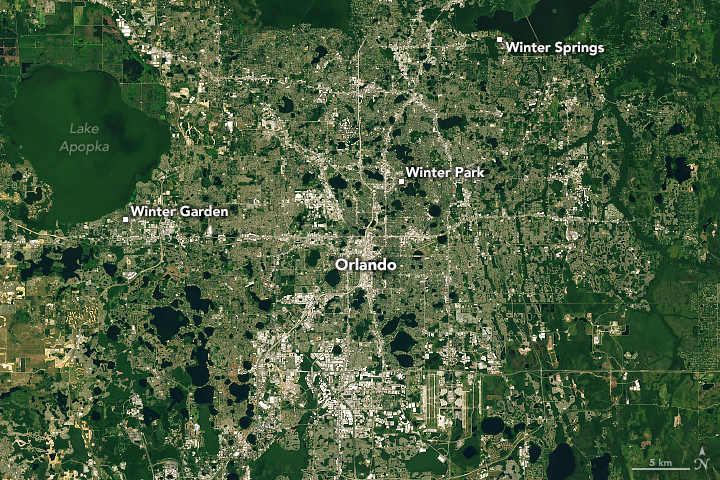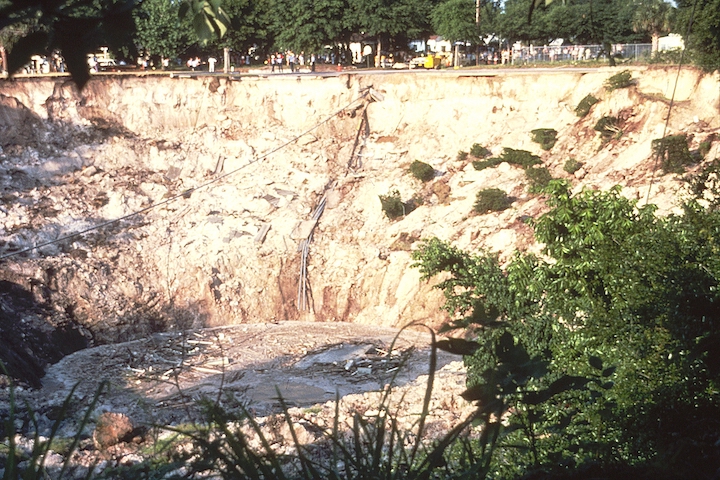
Wintry Florida
Downloads
- florida_winterplaces_oli2_2023266_lrg.jpg (4107x2738, JPEG)
- USGS_WinterParkFL1981Sinkhole-13.jpg (720x480, JPEG)
Metadata
- Sensor(s):
- Landsat 9 - OLI-2
- Data Date: September 23, 2023
- Visualization Date: December 21, 2023
With average summer temperatures above 80 degrees Fahrenheit and winter temperatures above 60°F, Florida is the warmest state in the contiguous U.S. The balmy winters—long a magnet for retirees and snowbirds—have also influenced a number of city names in the Sunshine State.
Of the more than 19,000 towns in the U.S., 12 have “winter” in their name, according to the Orlando Sentinel. Five are in Florida, and three are within 20 minutes of downtown Orlando. On September 23, 2023, the OLI-2 (Operational Land Imager-2) on Landsat 9 captured this image of the three near Orlando: Winter Park, Winter Garden, and Winter Springs.
Fertile soils began attracting settlers, especially citrus farmers, to the southern shore of Lake Apopka in the 1850s. The warm growing season prompted local farmers to name a new railroad stop “Winter Garden” in 1883, which later became the city’s name. More recently, a series of hard freezes in the 1980s pushed most citrus farmers farther south, and Landsat satellite images show new residential development has filled in most of the area’s open spaces in recent decades.
Like much of Central Florida, the land around Orlando is pockmarked with ponds and lakes. Many of these features originated as sinkholes—depressions caused by groundwater dissolving portions of the underlying limestone. Winter Park was established in the 1880s as a resort community by a pair of developers from New England. They were particularly impressed by the beauty of Lake Virginia and other nearby lakes and included “winter” in the city’s name as part of a strategy to attract wealthy northerners eager to escape cold New England winters.
The strategy proved successful. The city of 30,000 people now hosts lakefront mansions, a college, multiple museums, residential neighborhoods, and commercial districts. But the sinkholes have occasionally caused challenges. In 1981, a one-acre sinkhole in Winter Park (below)—among the largest ever observed in Florida—swallowed a home, part of a car dealership, and a community swimming pool. The lake that later formed in it was named Lake Rose, referring to the Winter Park resident whose home was destroyed.
Settlements north of Orlando along Lake Jesup have a long history as a transportation hub for fruit and other products. The community was traditionally called North Orlando. After some disagreement, the name was changed to Winter Springs in 1962 after the town annexed a large tract of land from a development company with that name. In the early 1960s, only 600 people lived in Winter Springs; the population has since soared to more than 33,000.
Temperatures in Florida have risen by more than 2°F (1°C) since the beginning of the 20th century due to climate change, according to NOAA’s state climate summaries. Much of that increase relates to nighttime temperatures, with the number of very warm nights during the 2015 to 2020 period more than double what they were in the mid-20th century.
As the climate continues to change, experts project that Florida will see increases in the intensity of extreme precipitation, which could worsen flooding throughout the state. They expect Florida’s growing population to face a rise in sea level of 1 to 4 feet (up to 1 meter) by 2100, though Orlando and its suburbs will be protected due to their inland location and high elevation compared to other parts of the state. Explore NASA’s sea level rise projection tool to learn more about how sea level rise will affect Florida.
References
- City of Winter Garden History of a Charming Little City with a Juicy Past. Accessed December 21, 2023.
- City of Winter Park History. Accessed December 21, 2023.
- City of Winter Springs The History of Winter Springs. Accessed December 21, 2023.
- Florida Climate Center Home. Accessed December 21, 2023.
- Florida Fruit Geek (2019) Florida Fruit Geek. Accessed December 21, 2023.
- Florida History Blog (2017, February 26) Winter Springs was almost called Semoran. Accessed December 21, 2023.
- NASA Earth Observatory Development of Orlando, Florida. Accessed December 21, 2023.
- NOAA (2022) State Climate Summaries. Accessed December 21, 2023.
- The Local Seasons In The Garden. Accessed December 21, 2023.
- The Orlando Sentinel (1971, September 29) North Orlando to become Semoran? No... Winter Springs. Accessed December 21, 2023.
- The Orlando Sentinel (2019, September 6) How did Central Florida become a Winter Wonderland? Accessed December 21, 2023.
- Observer (2023, March 29) Last Winter Garden citrus plant closes. Accessed December 21, 2023. ?
- Winter Park Magazine (2012) A Bright New England Town in Central Florida. Accessed December 21, 2023.
- Winter Park History Museum Winter Park Timeline. Accessed December 21, 2023.
NASA Earth Observatory images by Michala Garrison, using Landsat data from the U.S. Geological Survey. Sinkhole photo by Anthony Navoy for the U.S. Geological Survey. Story by Adam Voiland.
This image record originally appeared on the Earth Observatory. Click here to view the full, original record.
